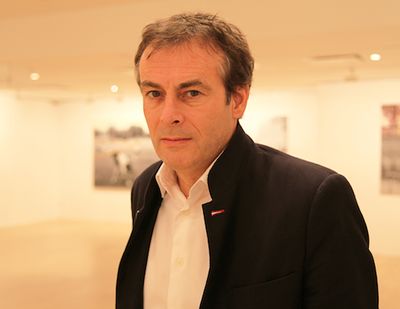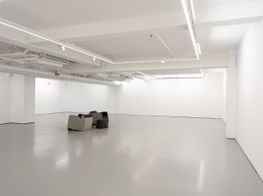Pascal De Sarthe

Pascal de Sarthe sits in his Hong Kong gallery office surrounded by art books – hundreds of them. They line the walls and they are piled up on his desk, and each book is thoroughly thumbed. In stark contrast to the looming bookshelves are three computer screens, which face de Sarthe at his desk – making him appear more a trader of shares, than a gallerist - but, as he laughingly remarks – ultimately a gallerist is a trader. de Sarthe certainly knows all about trading art – he has been doing it since the seventies, when together with his wife Sylvie de Sarthe, he first opened a gallery in Paris. The gallery was later relocated to the United States, and then to Hong Kong, where he and his wife now live. Initially the gallery in Hong Kong focused on the sale of secondary market masterpieces from de Kooning to Andy Warhol, but today represents and exhibits a diverse spectrum of international art, from works by important modern masters to fresh work from a generation of emerging talents. Managed by his son, Vincent de Sarthe, the gallery will shortly open a Beijing space dedicated solely to contemporary artwork from Chinese artists.
The books in de Sarthe’s library attest to his passion for art, and the computer screens and the gallery's evolution over the years reflect a man acutely aware of the changes in the art market. Ocula took the opportunity to interview de Sarthe on where his passion for art started, the gallery’s evolving ethos, its presentation at Art Basel in Hong Kong and finally its new space in Beijing.
Where did your passion for art begin?
As a child I always liked to draw and when I was 11, I read a book on Chaim Soutine and bought canvases, brushes, and oil paints and tried to copy the paintings reproduced in the book. That year, I started telling everyone that I would be an artist, adding that I would move to the USA when I was an adult. Later on, I discovered the New York school artists and did large canvases in the style of Barnett Newman and later, cardboard works similar to Bernar Venet’s and then did performances and installations. Art has always been a passion.
Together with your wife you founded de Sarthe Gallery in 1977. Can you please explain the gallery’s first exhibition and its ethos in these early days?
A friend of mine gave me a space for free to open a gallery. I was mostly showing works by my artist friends. We sold very little and it was not a memorable time except that I met my wife there. In 1978, I was asked to run the Galerie-Association Katia Pissarro in the Beaubourg area of Paris which I did it for two years. We showed the French Avant-Garde artists and mounted a different exhibition every month. I also had a show of my own work at the gallery. It was a great experience and I learned a lot about the gallery business then. Afterward I stopped doing art and solely focused on the art business. A year later, I fulfilled my childhood dream and moved with my wife and newborn child to San Francisco and opened a gallery there.
When the gallery opened in Hong Kong it initially focused on the secondary market of 19th and 20th century master paintings and sculptures. The approach of the gallery has changed drastically in more recent years and there is dual focus on historical masterpieces, as well as a focus on contemporary art. What prompted this change?
I love art history and read a lot about it. Except for a few exceptions, galleries in Hong Kong focus on their stable of artists. I have a 32 year long history of dealing in Asia. Asian collectors are very well aware of what happens in the art world, however new art aficionados in Asia are hungry for knowledge and aside from a business point of view, it is important for me to mount some historically relevant exhibitions. That was the reason for opening the gallery with an exhibit of masterworks by Zao Wou-Ki and following with eclectic exhibitions of John Wesley, Chen Zhen, Hans Hartung, Bernar Venet and Auguste Rodin amongst others.
Showing more contemporary art in Hong Kong is not a change of direction. We always showed contemporary art at our U.S. galleries however; our focus on Chinese contemporary art is new. It was prompted by our son Vincent, who joined our business four years ago. Following his great love for China he moved to Beijing and brought to the gallery a new direction by showing a younger generation of artists from China. This is a crucial art historical turning point; this younger generation of Chinese artists is the witness to major social, economic, and environmental changes in China today. They are more interested in the challenge of working with the unknown rather than attempting to revisit old traditional styles. Art history has not seen a major 'break from tradition' since the 1960’s and I am convinced that the next one will come from China.
How would you describe the ethos of the gallery now?
Focusing on 19th and 20th century Asian and Western masters as well as Chinese contemporary art. In Hong Kong, we will continue to work closely with collectors, providing them with great works by Monet, Picasso, Calder, Zao, Sanyu, Warhol and Chen Zhen, amongst others and have a few historically relevant exhibitions at least twice a year, plus be a venue in Hong Kong for our Chinese contemporary artists. The Beijing gallery will be a place to see new works from younger Chinese artists.
You have been coming to Asia since the early 80’s, building up a solid relationship with collectors in the region. Obviously the art landscape has changed dramatically since you first started coming. Are you able to define what you perceive as the biggest change in the collectors from this region?
The biggest change is the exponential growth of collectors in the region, combined with a stronger interest in Western art. When I first came to Asia in 1982, there was a huge interest for Western art in Japan; this market later developed making its way to Korea, China, and Southeast Asia. Their way of collecting changed with their interest in Western culture. Many collectors nowadays bring the art to their home. In the beginning, the collections stayed in storage and offices and occasionally went to collectors’ homes for their own enjoyment. This is still the case however, for many collectors, their home is becoming a place for social gatherings and the space is built around the art collection. For a few, they are even building museums to house their collections. This is new for China and the Eastern part of the region.
You currently are showing an exhibition entitled Pioneers of Modern Chinese Painting in Paris. Tell me about this exhibition.
We will present a rare collection of masterpieces by first and second generation Chinese artists who went to Paris to learn Western techniques. The Revolution of 1911 in China overthrew the monarch and resulted in the founding of the Republic of China, “The New Culture Movement” (1919 – 1949) was established, rejecting and criticizing Chinese tradition. In order to modernize the country and with the support of the government, Chinese art students were sent to Paris to learn Western Realism. Although they also went to Paris to learn about Western methods, the second generation of Chinese artists such as Zao Wou-Ki, Chu Teh-Chun and T’ang Haywen, did not have a governmental sponsorship and went on their accord. All three stayed and lived their entire lives in Paris and created freely, what can be called today, Chinese Abstraction. In presenting this exhibition, I wanted to show works from two successive periods that became fundamental in the revolution of Chinese modern art and are today’s most historical moments of Chinese 20th century art.
At Art Basel in Hong Kong you will be showing a combination of works from the artists in the Pioneer exhibition with work by young contemporary Chinese artists, such as Lin Jingjing, Wang Guofeng, Zhou Wendou and Zhao Jinhe. Tell me about how you believe the historical works interact with the contemporary artworks in the booth?
Once again, we will be pointing out the importance of art history. Without historical roots art cannot progress. When art historians define strong creative changes, it gives a base for younger artists to evolve and challenge themselves. Contemporary artists are well aware of the path followed by these masters. The major difference in today’s Chinese modernization is that most of the new generation of artists has no desire to live abroad. At a time when the Western art world has its eyes on China, disagreeing with historical references, these artists want to be part of the international forum of contemporary art impacting the global art scene with an Asian voice. For the artists we are working with, although they are well travelled, they have decided to continue to live in China.
In 2014, de Sarthe Gallery will inaugurate a second gallery space in Beijing. The second gallery will be dedicated to contemporary art from China. Tell me about the decision to open the space, and to focus on contemporary art from China.
Our son lives in Beijing. He studied art history in the States and has a great interest in contemporary art. At 29 years old it only makes sense that he works closely with artists of his generation. The gallery in Beijing will be a platform for this younger generation of Chinese artists.
The gallery has continued to evolve and adapt with the times. What do you see as the future for the art market?
That is a question I ask myself every day. I believe that a big part of our business as we know it today will be soon obsolete. The globalization of the art market and the impact of its rapid development in the Asian region will change the way this business is conducted.
How will de Sarthe gallery move with this?
We have to keep our eyes and minds wide open and be ready to adapt quickly to the evolution of the art market. -[O]











































































































































































